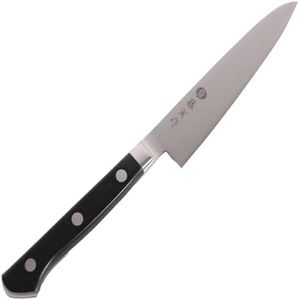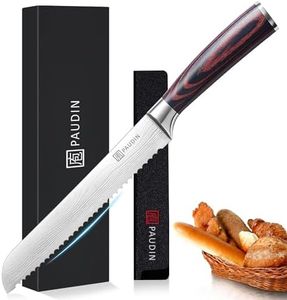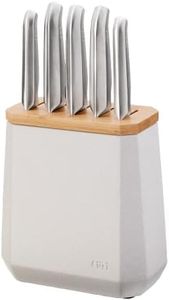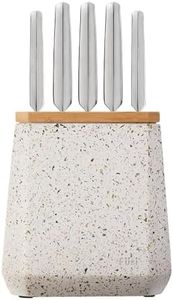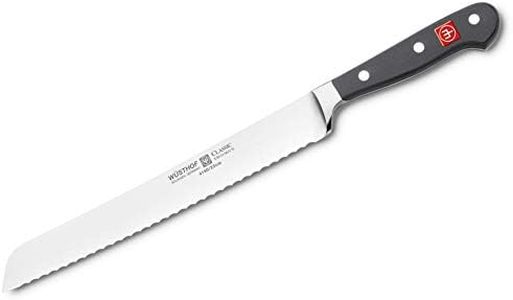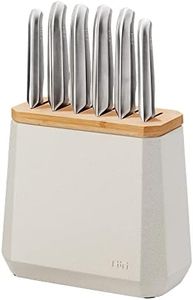We Use CookiesWe use cookies to enhance the security, performance,
functionality and for analytical and promotional activities. By continuing to browse this site you
are agreeing to our privacy policy
10 Best Bread Knives
From leading brands and best sellers available on the web.Buying Guide for the Best Bread Knives
Choosing the right bread knife can make slicing everything from crusty sourdough to delicate brioche much easier and cleaner. Bread knives are specialized tools designed to cut bread without squashing or tearing it. To find the best one for your kitchen, you'll want to consider several key features that affect how it handles different types of loaves and how comfortable it feels to use. Focusing on your typical uses—like slicing homemade artisan loaves, sandwich bread, or even tomatoes—will help you pick the most fitting knife.Blade LengthBlade length refers to how long the cutting edge of the knife is. It's important because a longer blade lets you cut through wide loaves in a single sawing motion, leading to cleaner slices with less effort. Bread knife blades typically range from about 7 to 10 inches. Shorter blades (7–8 inches) can be easier to manage for small hands or if you mostly cut sandwich bread, but they might struggle with bigger artisan loaves. Longer blades (9–10 inches) handle wider or denser loaves better but might feel a bit unwieldy for smaller items. Think about the size of the bread you usually cut to decide on the right length.
Serration StyleSerration style describes the shape and size of the 'teeth' along the blade’s edge. Serrations help the knife bite into crusty bread without slipping or crushing. There are fine (small) serrations and wide (scalloped) serrations. Fine serrations are good for soft bread, pastries, and foods like tomatoes, as they create smooth slices. Wider serrations are better at tackling thick, crunchy crusts. If you eat a variety of bread, opt for medium or varied serrations. Consider what you cut most often and choose the serration style that matches your usual loaf.
Blade MaterialBlade material affects the knife’s sharpness, rust resistance, and how much care it needs. The most common is stainless steel because it resists rust and lasts long, making it good for kitchens with busy routines. Carbon steel can hold a sharper edge but needs extra maintenance to prevent rust. Ceramic blades stay sharp for a long time and don’t rust but can chip if handled roughly. For most people, stainless steel offers the best balance of performance and care, while ceramic is good if you want light weight and sharpness but are careful with your tools.
Handle ComfortHandle comfort relates to the shape, size, and material of the knife's grip. Since bread knives often require a firm, steady grip for slicing, a comfortable handle prevents hand fatigue and offers better control. Handles can be made from wood, plastic, or composite materials. Wood is classic but needs more care; plastic is easy to clean; composites combine comfort and durability. Try to imagine how the handle would feel in your hand—if you have smaller hands or arthritis, a slimmer handle may feel better, while a larger, contoured handle provides more grip for bigger hands.
Balance and WeightBalance and weight refer to how the knife feels when held and moved during cutting. A well-balanced knife isn’t too heavy at the blade or the handle, making it easier to control and less tiring to use. Lighter knives are easier to maneuver for quick, short cuts, while heavier knives add more force to each slice, which helps with tougher crusts but can feel clunky for softer bread. Think about what feels better in your hand and how much bread you typically slice in one go—personal preference plays a big part here.
Maintenance NeedsMaintenance needs involve how easy the knife is to clean and sharpen. Bread knives with stainless steel blades and plastic or composite handles are generally the lowest maintenance—they can be hand-washed without worry. Wooden handles need drying soon after washing. Sharpening bread knives can be tricky due to the serrations; they usually require less frequent sharpening, but when needed, it’s often best done by a professional. If you prefer convenience, look for materials and designs that are easy to clean and rarely need sharpening.
